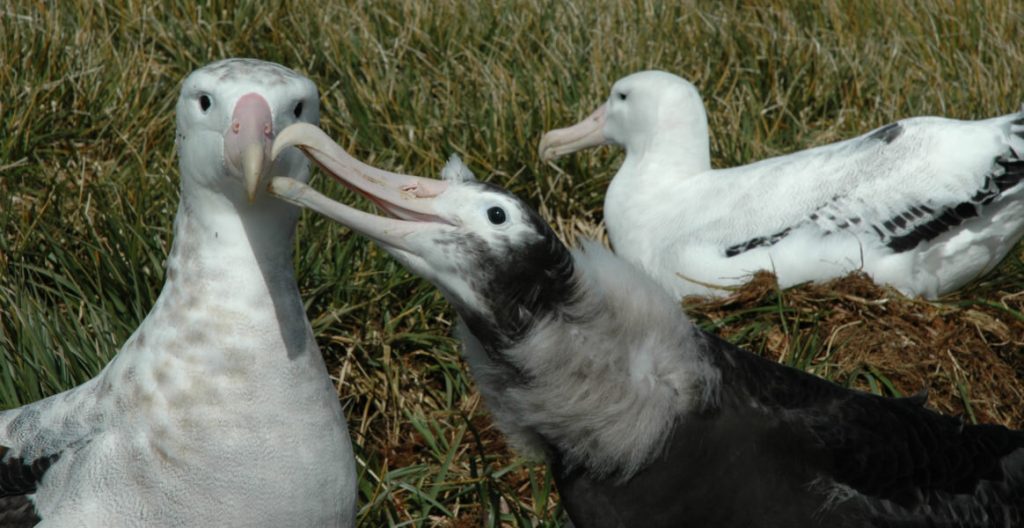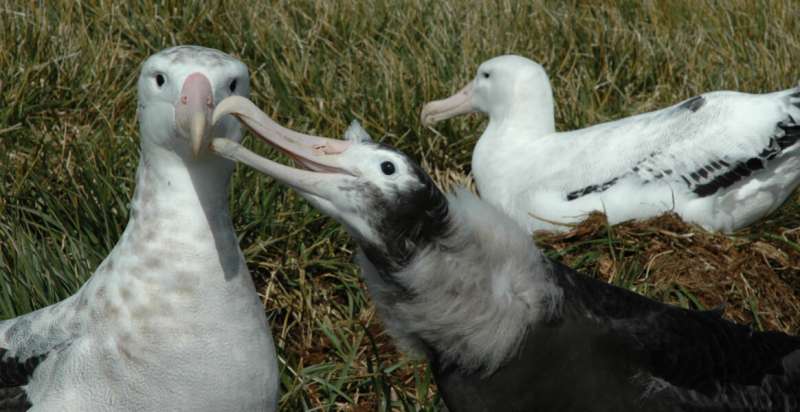
Albatrosses from space: Wildlife detectives needed (Image Credit: Phys.org)

British Antarctic Survey (BAS) and RSPB are recruiting albatross detectives to help to search for wandering albatrosses in satellite images taken from space in an effort to learn more about how these sentinels of the sea are being impacted by climate change, intensive fishing, and invasive species.
The Albatrosses from Space project is currently focusing on Wandering Albatrosses on South Georgia, located in the South Atlantic Ocean. Although wandering albatrosses nest in grassy, relatively flat terrain, the islands of South Georgia feature sheer, rocky cliffs and outcrops, making access dangerous and expensive for researchers. Using satellite imagery to count the birds is safer, causes no disturbance to the birds or their habitat, saves time and funding, and opens up previously inaccessible areas for surveying. The project is being led by the ‘Wildlife From Space’ team at BAS, which also monitors walruses, penguins, whales and seals via satellite imagery.
Dr. Peter Fretwell, who leads the Wildlife from Space team says, “The Wildlife From Space team have been using satellite images to detect albatrosses for many years, but never at this scale. There are over 20 main Wandering Albatross breeding sites in South Georgia, but only three of these are regularly monitored from the ground as most are difficult to access. Satellite imagery will help solve this issue by allowing us to complete remote counts of albatrosses at all breeding sites.”
Want to be an albatross detective?
Using high-resolution satellite images, BAS researchers have found a way to pin-point the albatrosses. The wingspan of a Wandering Albatross is over three meters—the greatest of any living bird. Their bodies alone are over a meter long, meaning they show up in satellite images as creamy white dots.
Counting individual albatrosses is a fantastic way for scientists to monitor populations and breeding numbers, and to evaluate the impact of conservation actions on albatross populations.
Anyone can take part in this project—you don’t need to be an expert, we’ll show you exactly what to look for in the images. Our long-term goal is to form a flock of albatross detectives so that together we can complete the first worldwide albatross census. Getting people involved at this early stage will help this project go from strength to strength and make a real difference to albatross conservation.
Dr. Marie Attard, who leads the Albatross from Space project says that “this project wouldn’t be possible without the help of the public. Satellite images of each breeding site is divided into thousands of square tiles so they are easier to search. Albatross will be present in some, but it would take too long for a few people to go through these alone! Each tile will be searched by six people. We consider an albatross to be present if multiple people tag the same creamy white dot.”
Sentinels of the sea
Albatrosses glide over the seas with exceptional ease, harvesting energy from the winds close to sea-level to gain lift, rarely needing to flap their wings. However, these remarkable creatures are struggling, with population numbers in decline. Fisheries, invasive species and climate change and all pose a serious threat. At sea, albatrosses contend with the perils of commercial fishing lines and trawl cables. It’s thought that around 100,000 albatrosses are killed by longline fishing gear every year.
Albatrosses can live well into their 50s, forming lifelong bonds with their mates. It takes almost a year from laying the egg to rearing a single chick for a wandering albatross. The parents then take off the following year to recover. This means populations recover slowly if adults die in fisheries, putting these species at real risk of disappearing if we don’t reverse the trend.
Explore further
Project: geohive.maxar.com/yellowjacket/login
Albatrosses from space: Wildlife detectives needed (2022, September 5)
retrieved 6 September 2022
from https://phys.org/news/2022-09-albatrosses-space-wildlife.html
part may be reproduced without the written permission. The content is provided for information purposes only.





